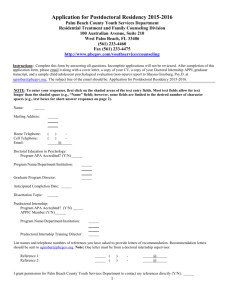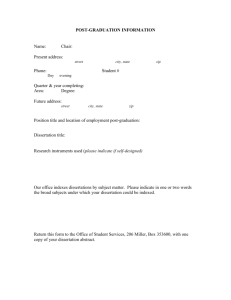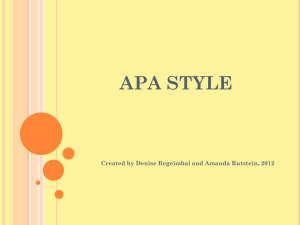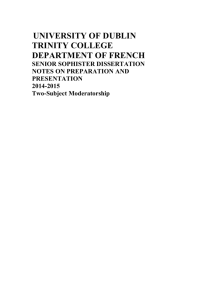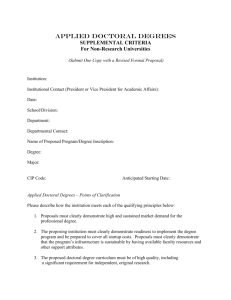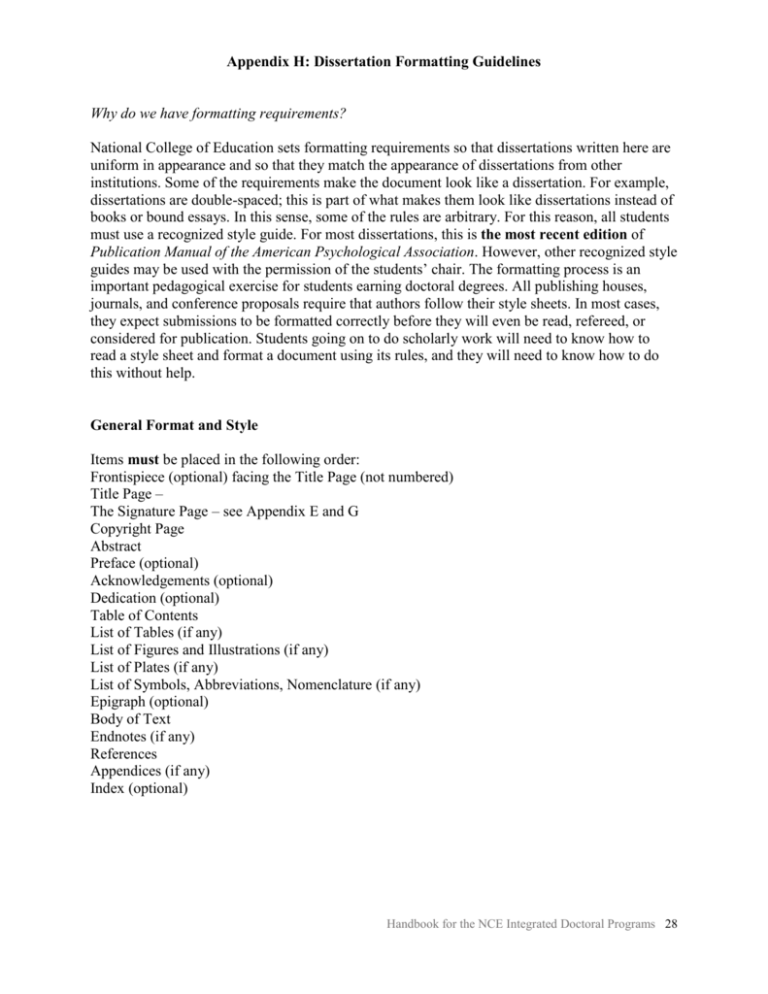
Appendix H: Dissertation Formatting Guidelines
Why do we have formatting requirements?
National College of Education sets formatting requirements so that dissertations written here are
uniform in appearance and so that they match the appearance of dissertations from other
institutions. Some of the requirements make the document look like a dissertation. For example,
dissertations are double-spaced; this is part of what makes them look like dissertations instead of
books or bound essays. In this sense, some of the rules are arbitrary. For this reason, all students
must use a recognized style guide. For most dissertations, this is the most recent edition of
Publication Manual of the American Psychological Association. However, other recognized style
guides may be used with the permission of the students’ chair. The formatting process is an
important pedagogical exercise for students earning doctoral degrees. All publishing houses,
journals, and conference proposals require that authors follow their style sheets. In most cases,
they expect submissions to be formatted correctly before they will even be read, refereed, or
considered for publication. Students going on to do scholarly work will need to know how to
read a style sheet and format a document using its rules, and they will need to know how to do
this without help.
General Format and Style
Items must be placed in the following order:
Frontispiece (optional) facing the Title Page (not numbered)
Title Page –
The Signature Page – see Appendix E and G
Copyright Page
Abstract
Preface (optional)
Acknowledgements (optional)
Dedication (optional)
Table of Contents
List of Tables (if any)
List of Figures and Illustrations (if any)
List of Plates (if any)
List of Symbols, Abbreviations, Nomenclature (if any)
Epigraph (optional)
Body of Text
Endnotes (if any)
References
Appendices (if any)
Index (optional)
Handbook for the NCE Integrated Doctoral Programs 28
Frontispiece
A frontispiece is an optional item. If used, it must be placed facing the title page. It will not be
numbered, and it will be microfilmed as the first page of the thesis.
Title page
See sample on next page. The date you include should reflect the date your degree will be
conferred, not the date that you prepared or submitted the material. Use the same month and year
that you chose on the application to receive a degree. There are only three months that degrees
are conferred: June, August, or December followed by the year.
Handbook for the NCE Integrated Doctoral Programs 29
Sample of Dissertation Title Page
DISSERTATION TITLE
Your Name
Full Name of the Doctoral Program
Submitted in partial fulfillment
of the requirements of
Doctor of Education
National College of Education
National Louis University
Month of Graduation, Year
Handbook for the NCE Integrated Doctoral Programs 30
The signature page – see Appendix E for sample of dissertation proposal signature page and see
Appendix G for dissertation signature page.
Copyright page
Copyright page does not show a page number. It should say, centered in the middle of the page:
Copyright by My Name, Year of degree conferral
All rights reserved
Nothing else should go on this page.
Abstract
An abstract, which is no more than 150 words, should clearly summarize the problem, method,
results, and conclusions. You should not include any other information such as the title of your
project, or your name. The Abstract page should be numbered in lower-case roman numerals in
bottom center.
Preface (optional)
A preface contains material which is introductory but is not included in the introduction. For this
reason, not everyone needs to include a preface. You should also show the page numbers on the
bottom center. Keep in mind that all the pages before this count in the page count, even if they
are not printed on the page itself. These page numbers should be in lower-case roman numerals.
Acknowledgements (optional)
This section is optional, but most students find they would like to thank the various people in
their lives who helped them to prepare the project, or supported them during the time in which
they prepared it. This is also the place to thank institutions, funding sources, libraries, archives,
and any anonymous readers or editors. The pages of the acknowledgements should show a
number in roman numerals on the bottom center of the page.
Dedication (optional)
The text on this page should be simple and short. It does need to be labeled “Dedication” as the
text makes this clear, and it does not require explanation (such explanations are for the
acknowledgments). Nothing else should appear on this page, including a page number.
Table of Contents
The Table of Contents must include a listing of all items in the thesis. You should not list the title
page, the copyright page, the dedication, the epigraph, the table of contents, or the approval
sheet. Headings and sub-headings must be consistent between the Table of Contents and the
body of the text. All capitalization, punctuation, abbreviations, etc., must be consistent amongst
the titles in the Table of Contents and Lists of Tables and Figures, and the actual titles as they
appear in the body of the text. The Table of Contents should show page numbers as lower
Handbook for the NCE Integrated Doctoral Programs 31
case roman numerals at the bottom center. The top of each page of the table of contents
should have a one inch margin; the top of the first page should show the title, all in caps: TABLE
OF CONTENTS. All the page numbers should be aligned and flush right.
Handbook for the NCE Integrated Doctoral Programs 32
Sample Table of Contents
TABLE OF CONTENTS
ABSTRACT ....................................................................................................................... iii
ACKNOWLEDGEMENTS ............................................................................................... iv
List of Tables ...................................................................................................................... v
List of Figures .................................................................................................................... vi
CHAPTER ONE .................................................................................................................1
Level 1 .................................................................................................................................1
Level 2 ..................................................................................................................................3
Level 3 .........................................................................................................................7
Level 4 if needed .........................................................................................................9
CHAPTER TWO ..............................................................................................................13
Level 1 ...............................................................................................................................13
Level 2 ...............................................................................................................................20
Level 3 .......................................................................................................................32
Level 4 and so on ......................................................................................................47
CHAPTER THREE .........................................................................................................60
Level 1 ...............................................................................................................................60
Level 2 ...............................................................................................................................67
Level 3 ..........................................................................................................................75
CHAPTER FOUR .............................................................................................................85
Level 1 ...............................................................................................................................85
Level 2 .............................................................................................................................102
Level 3 ......................................................................................................................122
And you got the idea ...............................................................................................145
CHAPTER FIVE ...........................................................................................................168
Level 1 ..............................................................................................................................168
You May Have Level 2 Here as Well .............................................................................188
And Level 3 too . .........................................................................................................200
References .......................................................................................................................205
Appendix A: Title ............................................................................................................220
Appendix B: Title ...........................................................................................................221
Handbook for the NCE Integrated Doctoral Programs 33
List of Tables (if any)
List of Figures and Illustrations (if any)
List of Symbols, Abbreviations, Nomenclature (if any)
Epigraph (optional)
An epigraph is a short quote relevant to your whole project. Like the dedication, it stands alone
and without further explanation. You may choose to provide the source, though the expectation
is that a reader will recognize it if you do not. No other text should appear on the page, including
a page number. Example:
The ‘Enlightenment,’ which discovered the liberties, also invented the
disciplines.
Michel Foucault, Discipline and Punish: The Birth of the Prison
Body of text (The following guide lines are based on APA style, if you are approved to use a
different style guide, some of these guidelines may not apply.)
You should divide the main text of your dissertation into chapters. These divisions should
reflect both the internal logic of your project, and also facilitate your reader’s experience of the
text. The first page of the body of text should be marked “1” at bottom middle page. Set
uniform margins of at least 1 in. (2.54 cm) on the top, bottom, left, and right of every page. Use
your word-processing software to add a header that will appear at the top of every page that
includes the running head and the page number. The header appears within the top margin, not
below it. Type size should be 12-point.
Generally, all textual material should be double-spaced (this includes spaces between sections).
However, single-spacing may be used in setting off long quotations (40 or more words),
interview excerpts, and field notes. The left-hand margin must be large enough for binding (1½
inches); a 1-inch margin should be used on the remaining sides of the page. Be consistent with
font. Recommended fonts: Times New Roman, Arial, Verdana, and Garamond. All the
references must be in the text; do not use footnotes. For emphasis in the text: Do use italics. Do
not underline. Do not use bold. Insert only one space after period. Align text to the left.
Headings. Use levels of headings properly and consistently (See APA for guidance.) Be
consistent in your use of headings across the chapters of your work. If you include a level of
headings (1st, 2nd) in the Table of Contents for one chapter then you must include that level of
headings for all chapters. Do not end a page of text with a heading.
There are 5 heading levels in APA. Regardless of the number of levels, always use the headings
in order, beginning with level 1. The format of each level is illustrated below:
Handbook for the NCE Integrated Doctoral Programs 34
APA Headings
Level Format
1
Centered, Boldface, Uppercase and Lowercase Headings
2
Left-aligned, Boldface, Uppercase and Lowercase Heading
3
Indented, boldface, lowercase heading with period.
4
Indented, boldface, italicized, lowercase heading with period.
Indented, italicized, lowercase heading with period.
5
Example:
CHAPTER TWO
The Review of the Literature
Introduction
Use this one for sub-headings.
Avoid hanging quotations. It is a quotation without introduction; it just “hangs” there. Introduce
quotations with specific information in one or two sentences. These sentences provide context
for the quotation and enable your reader to understand why the quotation is important. As a
ubiquitous imaginary researcher Smith (2008) argues:
Use quotations at strategically selected moments. You have probably been told by
teachers to provide as much evidence as possible in support of your thesis. But packing
your paper with quotations will not necessarily strengthen your argument. (pp. 21-22)
Once you have inserted your quotation, along with its context and attribution, do not stop. Your
reader still needs your assessment of why the quotation holds significance for your study. And
this was a nice example of the points we wanted to make.
And here is more advice:
1. Introduce a block quotation with your own words followed by a colon or comma.
2. Indent. You normally indent 4-5 spaces for the start of a paragraph. When setting up a
block quotation, indent the entire paragraph once from the left-hand margin.
3. You may use single space within the block quotation; the font size remains the same
4. Do not use quotation marks at the beginning or end of the block quote - the indentation is
what indicates that it is a quotation.
Follow up a block quotation with your own words.
Keep periods and commas within quotation marks. For example:
Handbook for the NCE Integrated Doctoral Programs 35
According to Jones (2000), students "dread APA style," but many of his colleagues urged him to
"keep teaching it, regardless" (p. 19).
Place colons and semicolons outside quotation marks. For example:
Williams (2002) described APA style as "a must in dissertations"; her colleagues agreed.
Place a question mark or exclamation point within closing quotation marks if the punctuation
applies to the quotation itself. Place the punctuation outside the closing quotation marks if the
punctuation applies to the whole sentence.
A student asked, "Do I really need APA?"
Does Dr. Hairsplitter always say to her students, "You really need to use APA"?
Each of your tables and figures should have a number, and they should be numbered
consecutively throughout the manuscript. That is, the first table is table 1, the second table 2, and
so forth, even if they appear in different chapters or sections. You should also give your tables
and figures descriptive titles, which you should single-space. You may also choose to include a
short description of the table with the title; it too should be single spaced. This material should
appear on the same page as the table itself, and you should try to format the table and its
accompanying text so that there are no large empty spaces in your manuscript.
Example:
Table 1
Correlation coefficients between Gender (G), Age (A), and APA proficiency test (APAPT)
Figure 1. The popularity of APA formatting style across USA universities.
Illustrations
Illustrations should be positioned as the main text (the type reading across the 8-1/2 inch
dimension). If figures or tables cannot be printed in the same direction as the text, they can be
rotated to landscape orientation in such a way that the top of the figure is oriented to the inside
(1-1/2 inch margin side) and the caption placed at the bottom (along the right-hand side of the
page). The page number must appear in the usual place.
Handbook for the NCE Integrated Doctoral Programs 36
References
Follow the guidelines of the current Publication Manual of the American Psychological
Association.
Appendices (if any)
This is the place to include materials to which you would like your reader to have access, but
which are not necessary to the main narrative of your argument. This is the place, for example, to
include your raw data, letters of permissions, the texts of surveys or other materials you used in
your research, translations or editions of primary texts which are not published, and so forth.
If you do include appendices, you should give them both a generic and a descriptive title (e.g.
Appendix A: Yet More Stuff about the Formatting). The title is centered, and the material is
included on the same page.
Plagiarism
All work that is not your own must be documented by proper citation of sources. Offering the
work of another as one’s own, even unintentionally, is a serious offense covered by the NLU
policy on academic integrity, and is especially problematic in a research document which
purports to be original work. Consult the Library Guide on Understanding Citing & Plagiarism
and the NLU Student Handbook. Both can be found at
http://libguides.nl.edu/content.php?pid=16608&sid=5360444
Proofreading
It is your responsibility to insure that the dissertation is properly formatted and thoroughly
proofread. You should always proofread after using the spellcheck, as many errors may be
missed by automated spellcheck functions. A dissertation submitted to the dissertation committee
Chair and members, which shows an obvious lack of proofreading will be returned to you for
additional revisions. Students may procure the services of an editor who can assist in formatting,
copy-editing, and other non-content related edits.
Handbook for the NCE Integrated Doctoral Programs 37




